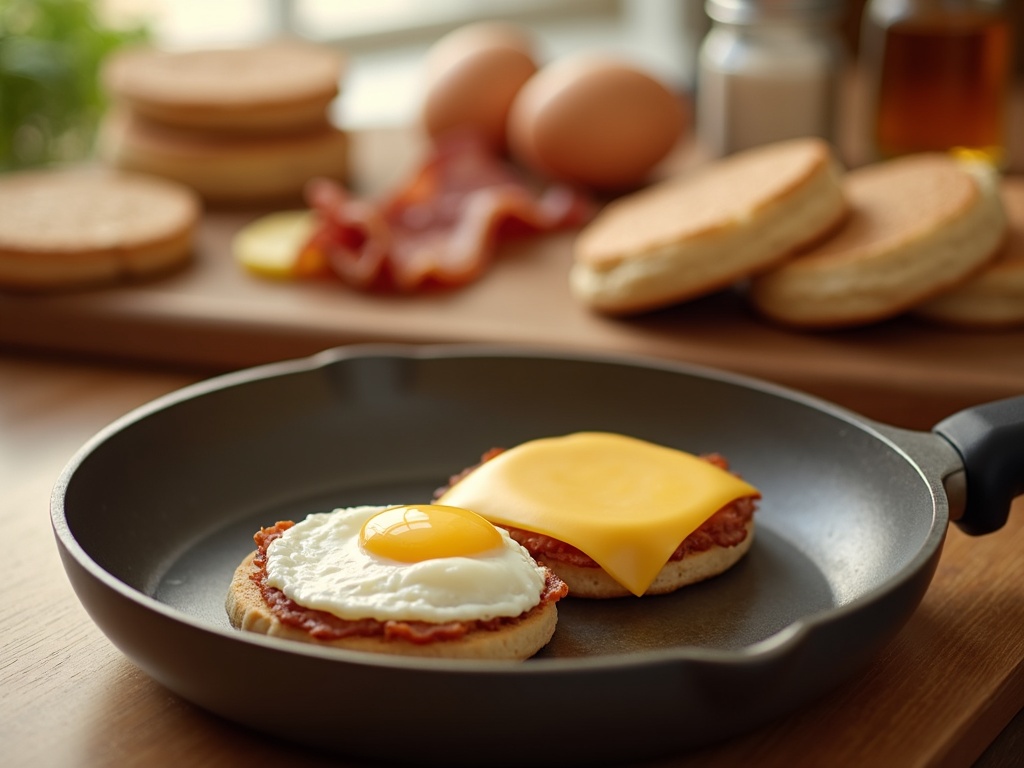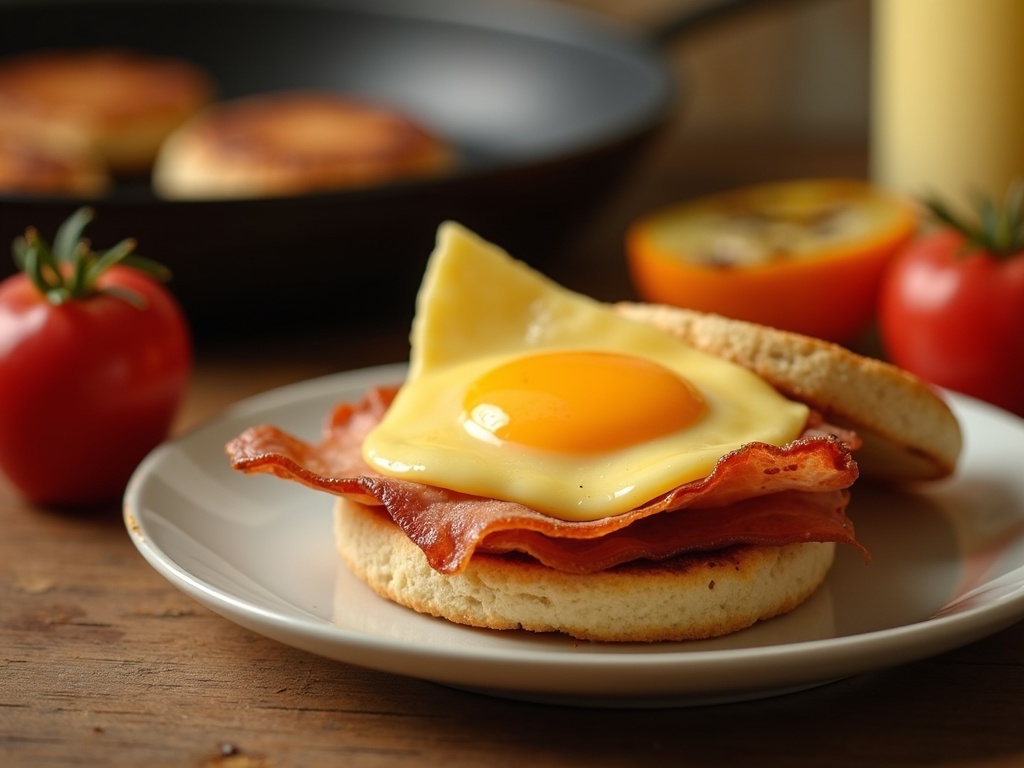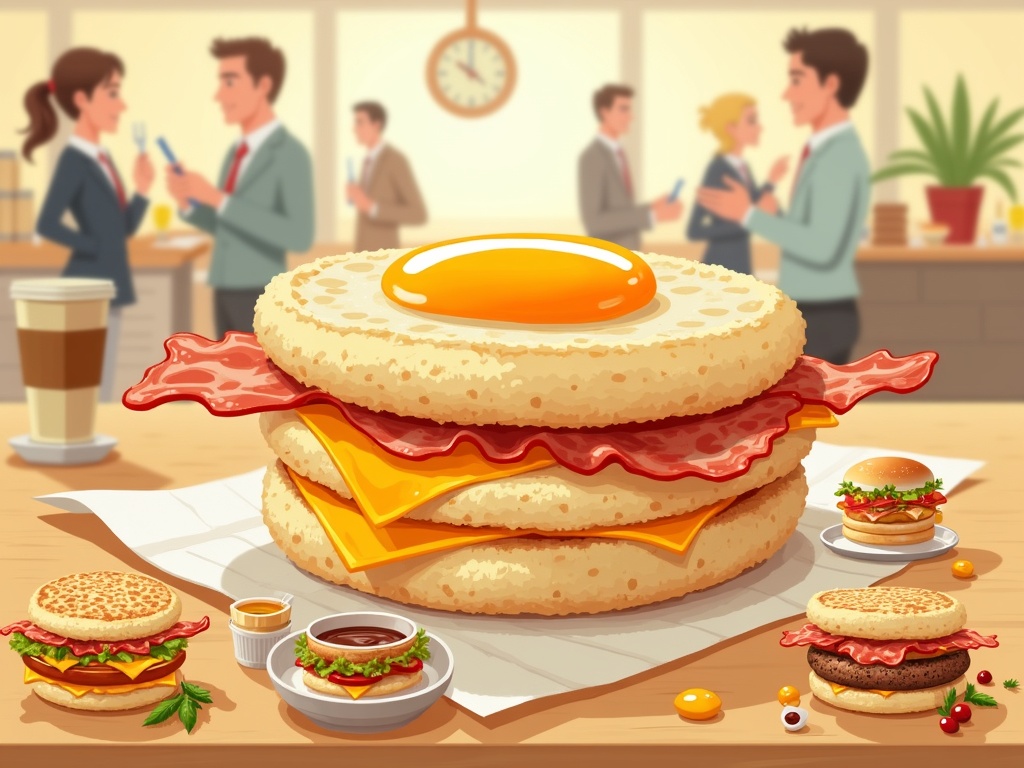The McMuffin revolutionized breakfast culture in America when McDonald’s introduced it in 1972, transforming morning meals from sit-down affairs to convenient, portable options for busy commuters. With its simple yet ingenious combination of English muffin, egg, Canadian bacon, and cheese, this iconic sandwich now sells over 1 billion units globally each year, inspiring countless imitations across the fast food industry.
Find In This Article
Key Takeaways
- The classic Egg McMuffin contains 300 calories, 12g of protein, 30g of carbohydrates, and 12g of fat, making it a relatively balanced fast food breakfast option.
- McDonald’s has expanded the McMuffin family to include variations like the Sausage McMuffin and Bacon Egg and Cheese McMuffin to cater to different preferences.
- Making a perfect homemade McMuffin requires proper technique, including toasting the English muffin, using a ring mold for the egg, and strategic layering of ingredients.
- Common mistakes when making homemade McMuffins include skipping the toasting step, overcooking the egg, and incorrect ingredient assembly order.
- Healthier adaptations include using whole grain muffins, egg whites, turkey bacon, and adding fresh vegetables like spinach, tomatoes, or avocado.
The Fast Food Icon That Changed Breakfast Forever
The McMuffin isn’t just a sandwich—it’s a cultural phenomenon that forever changed how Americans start their day. I can trace this breakfast revolution back to 1972 when McDonald’s first introduced this portable morning meal, setting off a chain reaction that would transform the fast food landscape.
The Birth of a Breakfast Revolution
The story of the McMuffin represents one of the most successful product launches in fast food history. Before this ingenious creation, breakfast was largely confined to sit-down restaurants or home kitchens. McDonald’s saw an opportunity to create something that busy commuters could grab on their way to work—portable, satisfying, and consistent.
The concept was revolutionary in its simplicity: an English muffin topped with a perfectly round egg, Canadian bacon, and American cheese. This winning combination struck a chord with consumers looking for a quick morning option that still felt like a proper breakfast.
The numbers tell the story of its massive success. According to 2021 data, McDonald’s sells over 1 billion McMuffins globally per year. That’s approximately 2.7 million McMuffins every single day, making it one of the most consumed breakfast items on the planet.
Nutritional Profile and Variations
The classic Egg McMuffin packs quite a nutritional punch in its compact form:
- 300 calories per serving
- 12g of protein to kickstart your day
- 30g of carbohydrates for energy
- 12g of fat for satiation
- 560mg of sodium
This balanced nutritional profile makes it a more reasonable option compared to many other fast food breakfast choices. The protein content is particularly notable, offering a decent amount to help you feel full through the morning.
Over the years, McDonald’s has expanded the McMuffin family to include variations like the Sausage McMuffin, Bacon Egg and Cheese McMuffin, and even vegetarian options in some markets. Each variation maintains the core elements that made the original so successful while catering to different taste preferences.
I’ve noticed that the McMuffin’s influence extends far beyond McDonald’s itself. The creation sparked an entire breakfast sandwich category, with virtually every major fast food chain now offering their own version. From Burger King’s breakfast sandwiches to Starbucks’ breakfast offerings, the McMuffin’s DNA is evident throughout the breakfast foods landscape.
The sandwich’s staying power is a testament to its perfect formula—protein, carbs, and fat in a convenient handheld package. Even as McDonald’s breakfast hours have expanded and the menu has evolved, the McMuffin remains the cornerstone of their morning offerings.
For many busy professionals, parents rushing kids to school, or anyone looking for a quick morning meal, the McMuffin represents reliability in a hectic world. Its consistent taste and quality across thousands of locations have cemented its place in the breakfast pantheon.
Whether you’re a fan of the McDonald’s all-day breakfast menu or specifically seek out their morning items during traditional McDonald’s breakfast hours, the McMuffin stands as a testament to how innovation in simplicity can change an entire category of dining.

Crafting the Perfect McMuffin at Home
I’ve perfected my homemade McMuffin technique after countless breakfast experiments. The beauty lies in its simplicity—just a few quality ingredients coming together for that iconic breakfast sandwich experience without leaving your kitchen.
Essential Ingredients and Preparation
To create an authentic McMuffin experience at home, I start with these basic components:
- English muffin (choose whole wheat for extra fiber or classic for traditional flavor)
- 1 fresh egg
- 1 slice American or cheddar cheese
- Protein option: Canadian bacon, sausage patty, or regular bacon
- Butter for cooking
- Salt and pepper to taste
The magic happens in the assembly process. I first split and toast the English muffin until it’s lightly browned and crisp around the edges. While that’s happening, I melt a small pat of butter in a non-stick pan over medium heat. The secret to that perfect round egg is using a ring mold—I sometimes use a cleaned tuna can with both ends removed in a pinch.
I place the ring in the pan, crack the egg directly into it, then break the yolk with a fork (unless I’m in the mood for a McDonald’s breakfast style runny center). A dash of salt and pepper is all the seasoning needed. The timing is critical here—about 2-3 minutes gives you that ideal slightly runny yolk that creates the perfect sauce for your sandwich.
While the egg cooks, I quickly heat my protein choice in the same pan. The breakfast foods industry secret is to place the cheese on the protein during the last 30 seconds of cooking, which ensures it melts perfectly.
The layering order matters: bottom muffin half, cheese-topped protein, perfectly cooked egg, then the top muffin half. This ensures the cheese melts from both directions, creating that gooey center that makes a McDonald’s breakfast hours favorite so satisfying.
I’ve found this homemade version even more delicious than the original—it’s fresher, can be customized to your exact preferences, and provides that same satisfying breakfast experience without the drive-thru line. Plus, making these at home lets you control the quality of ingredients while still enjoying that iconic taste that’s made the McMuffin a morning staple.

Common Mistakes That Ruin Your McMuffin
I’ve noticed that making the perfect homemade McMuffin isn’t as straightforward as it seems. Even with the right ingredients, several common errors can transform your breakfast sandwich from delicious to disappointing.
Assembly and Preparation Errors
Skipping the toasting step is perhaps the most frequent mistake I see people make. An untoasted English muffin quickly absorbs moisture from the egg and other ingredients, resulting in a soggy breakfast sandwich that falls apart. Taking just a minute to toast your muffin creates that essential crisp exterior that holds everything together.
Overcooking the egg is another critical error. When an egg is cooked too long, it develops a rubbery texture that’s unpleasant to bite into. I aim for a perfectly set white with a slightly soft (but fully cooked) yolk for the best McDonald’s breakfast experience at home.
Many home cooks also overlook the importance of seasoning. Even a simple egg needs proper salt and pepper to enhance its flavor. Without adequate seasoning, your breakfast foods will taste flat compared to restaurant versions.
Ingredient Selection Issues
Choosing the wrong cheese significantly impacts your McMuffin quality. American cheese slices melt beautifully on a hot egg, while harder cheeses might not melt properly before the sandwich cools. I’ve found that pre-sliced American cheese works best for that authentic McDonald’s breakfast taste and texture.
The assembly order matters more than you might think. Placing ingredients in the wrong sequence affects both temperature and texture. The optimal arrangement places the cheese directly on the hot egg so it melts properly, with meat (if using) below the egg to keep it warm. This strategic layering ensures every bite has the perfect balance of flavors and textures in your McDonald’s breakfast sandwich.
When I make my McMuffins at home, I follow a specific sequence:
- Bottom toasted muffin half
- Meat (if using)
- Egg with cheese melted on top
- Upper toasted muffin half
This structure keeps everything hot and prevents the bread from getting soggy too quickly.
By avoiding these common pitfalls, I can create breakfast sandwiches that rival anything from the McDonald’s all-day breakfast menu. With proper technique, my homemade McMuffins deliver that satisfying combination of crispy, creamy, and savory elements that make for a perfect breakfast experience.
Create Your Signature McMuffin
I’ve discovered that making your own signature McMuffin at home gives you complete control over ingredients and flavors. While the classic McDonald’s breakfast sandwich is delicious, creating your own version allows for personalization based on your taste preferences and dietary needs.
Savory Variations
The beauty of homemade McMuffins lies in their versatility. For a veggie-friendly option, I start with a toasted English muffin and add sautéed mushrooms, bell peppers, and onions. The vegetables provide a hearty texture while keeping the sandwich light and nutritious. Adding sliced avocado brings creaminess and healthy fats that make this meat-free version satisfying.
For those who enjoy some heat, a spicy McMuffin variation hits the spot. I incorporate thinly sliced jalapeños or spicy chicken sausage to kick things up a notch. Pairing these with pepper jack cheese creates a breakfast sandwich with the perfect amount of heat. The spiciness wakes up your taste buds and provides a fantastic alternative to the traditional McD breakfast experience.
My deluxe edition takes inspiration from gourmet cafés. I layer wilted spinach, thick-cut tomato slices, and a homemade garlic aioli on top of the protein. The combination of fresh vegetables and creamy spread elevates the humble McMuffin to restaurant quality. This option works great when I’m hosting brunch or want to treat myself to something special without leaving home.
Sweet and Customizable Options
When my sweet tooth calls, I transform the McMuffin concept entirely. I brush the English muffin with melted butter and sprinkle it with cinnamon sugar before toasting. Then I top it with Greek yogurt and fresh berries or sliced bananas. This sweet alternative makes a perfect light breakfast or mid-morning snack that satisfies cravings without being too heavy.
The best part about creating signature McMuffins is adapting them to specific dietary needs. Here are some customizable options to consider:
- Gluten-free: Substitute traditional English muffins with gluten-free alternatives
- Low-carb: Use portobello mushroom caps or cauliflower rounds instead of muffins
- High-protein: Add extra egg whites or lean turkey for an after-workout boost
- Dairy-free: Replace cheese with nutritional yeast or dairy-free cheese alternatives
- Plant-based: Use tofu scramble and plant-based sausage for a completely vegan option
I’ve found that prep is key when making custom McMuffins at home. Cooking components in advance and storing them separately in the refrigerator makes morning assembly quick and convenient. This approach brings the convenience of McDonald’s all-day breakfast into your kitchen, allowing you to enjoy your signature creation whenever cravings hit.
The timing flexibility is another advantage of homemade versions. Unlike navigating McDonald’s breakfast hours, you can prepare these any time of day. I often make extra components on Sunday to enjoy custom McMuffins throughout the busy workweek.
Experimenting with different breakfast foods in your McMuffin creates endless possibilities. From international flavors like feta and za’atar to regional American tastes like pimento cheese or maple butter, the humble English muffin becomes a canvas for culinary creativity. This adaptability keeps breakfast exciting and tailored exactly to your preferences.
Healthier McMuffin Adaptations
I’ve discovered several ways to transform the classic McMuffin into a more nutritious meal without sacrificing flavor. Making simple ingredient swaps can significantly improve the nutritional profile of this popular breakfast food while maintaining its satisfying taste.
Better Base and Protein Choices
Starting with the foundation, I recommend swapping the standard English muffin for a whole grain version. This simple change adds fiber and complex carbohydrates that keep you fuller longer compared to refined white flour options. The nutty flavor actually complements the other ingredients beautifully.
For the protein component, egg whites serve as an excellent alternative to whole eggs. They contain most of the protein but cut out nearly all the fat and cholesterol. If you’re making McDonald’s breakfast at home, you can easily separate eggs yourself or purchase cartons of egg whites.
Turkey bacon offers a leaner option than traditional pork bacon, with less fat and fewer calories. For those following plant-based diets, several meat alternatives now mimic the texture and flavor of bacon while providing protein from vegetable sources.
Flavorful Additions and Enhancements
I’ve found that low-fat cheese varieties can reduce the overall calorie content while still providing that essential melty element that makes a McDonald’s breakfast sandwich so satisfying. Options like reduced-fat cheddar, part-skim mozzarella, or even dairy-free alternatives work well.
Adding fresh vegetables transforms your McMuffin into a nutrient powerhouse. Consider these additions to boost both flavor and nutrition:
- Sliced tomatoes for vitamin C and juiciness
- Baby spinach leaves for iron and folate
- Sliced avocado for healthy fats and creaminess
- Thinly sliced red onion for a flavor kick
- Fresh herbs like basil or cilantro for brightness
The beauty of making your own McDonald’s breakfast at home is the control you have over ingredients and portions. By incorporating these healthier adaptations, I’ve created versions with up to 30% fewer calories and significantly more nutrients than the original.
These adaptations work perfectly whether you’re rushing out the door on weekday mornings or enjoying a leisurely all-day breakfast on the weekend. The best part? You won’t feel like you’re missing out on the classic McMuffin experience—just enhancing it.
Tips for Restaurant-Quality Results
Getting that authentic fast food taste at home is easier than you might think. I’ve discovered a few tricks that make homemade McMuffins taste just like the ones from McDonald’s breakfast menu. With these simple adjustments, you’ll create a sandwich that rivals the real thing.
Perfect Your Technique
The secret to restaurant-quality results starts with the egg. Using a ring mold creates that perfectly round shape that fits neatly on your English muffin. Simply place the ring on a hot pan, crack an egg inside, and cook until set. This simple tool transforms your breakfast from homemade to professional-looking.
Pre-warming your meat is another game-changer. Cold Canadian bacon or sausage patties can cool down your sandwich too quickly. I like to give them a quick sear in the pan after cooking the eggs, ensuring every component of your breakfast foods sandwich stays warm from first bite to last.
For that perfect cheese melt, place your cheese slice directly on the hot egg immediately after cooking. The residual heat gently melts the cheese without overheating it. If you’re aiming for even better melting, consider using pre-grated cheese instead of slices – it distributes more evenly and melts faster.
Timing Is Everything
The difference between a good McMuffin and a great one often comes down to serving temperature. I’ve found that McDonald’s breakfast sandwiches are best eaten immediately after assembly. Even waiting just five minutes can cause the English muffin to become soggy as steam from the hot ingredients gets trapped.
If you’re making multiple sandwiches, consider using the assembly line approach. Toast all your muffins first, then cook all your eggs, followed by warming the meat. This ensures that when it’s time to put everything together, you can serve them promptly while each component is at its peak temperature and texture.
These small but significant adjustments will help you create breakfast sandwiches at home that taste remarkably similar to what you’d get during McDonald’s all-day breakfast hours. The best part? You can customize them exactly to your taste while still maintaining that classic flavor profile everyone loves.

Sources:
The Fast Food Revolution by Eric Schlosser
The Rise of Coffee Culture in America by Jeffrey H. Schwartz
Nutritional Information: McDonald’s Menu Items (McDonald’s Website)
Breakfast Menu Items: A Historical Overview by Rebecca S. Silvers
The Psychology of Fast Food by Emma L. Rodger

